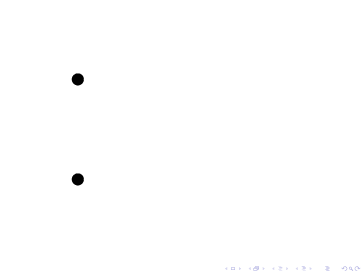This division of the aximation can be achieved with the interval option as follows: the movie is always 100 time units (let's call them axoseconds) long. interval specifies in which time slot an object should evolve from its start to its end, the so-called active interval.
The scattering reaction mentioned above can then be represented as follows:
$plu = point({"type" => "empty",
"coordinates" => [[-100,-50]]});
$plo = point({"type" => "empty",
"coordinates" => [[-100,50]]});
$p1 = point({"type" => "empty",
"coordinates" => [[-20,20]]});
$p2 = point({"type" => "empty",
"coordinates" => [[20,-20]]});
$pro = point({"type" => "empty",
"coordinates" => [[100,50]]});
$pru = point({"type" => "empty",
"coordinates" => [[100,-50]]});
line({"foot" => [${$plo}{"coordinates"}],
"head" => [${$plo}{"coordinates"},${$p1}{"coordinates"}],
"text" => "\$e^-\$",
"textpos" => [[.5,15]],
"color" => "Blue",
"staythere" => 1,
"interval" => [0,40]});
line({"foot" => [${$plu}{"coordinates"}],
"head" => [${$plu}{"coordinates"},${$p2}{"coordinates"}],
"textpos" => [[.5,15]],
"text" => '$e^-$',
"color" => "Green",
"staythere" => 1,
"interval" => [0,60]});
line({"foot" => [${$p2}{"coordinates"}],
"head" => [${$p2}{"coordinates"},${$pru}{"coordinates"}],
"staythere" => 1,
"fixedwiggles" => 0,
"text" => '$e^-$',
"textpos" => [[.5,15]],
"wiggles" => 25,
"color" => "Green",
"interval" => [60,100]});
line({"foot" => [${$p1}{"coordinates"}],
"staythere" => 1,
"text" => '$e^-$',
"textpos" => [[.5,15]],
"color" => "Blue",
"head" => [${$p1}{"coordinates"},${$pro}{"coordinates"}],
"interval" => [40,100]});
photon({"foot" => [${$p1}{"coordinates"}],
"head" => [${$p1}{"coordinates"},${$p2}{"coordinates"}],
"color" => "Red",
"fixedwiggles" => 0,
"text" => '$\gamma$',
"textpos" => [[.5,20]],
"wiggles" => 25,
"staythere" => 1,
"interval" => [40,60]});
point({"coordinates" => [${$plo}{"coordinates"},
${$p1}{"coordinates"}],
"type" => "ccirc",
"interval" => [0,40]});
point({"coordinates" => [${$plu}{"coordinates"},
${$p2}{"coordinates"}],
"type" => "ccirc",
"interval" => [0,60]});
point({"coordinates" => [${$p1}{"coordinates"},
${$p2}{"coordinates"}],
"type" => "ccirc",
"interval" => [40,60]});
point({"coordinates" => [${$p1}{"coordinates"},
${$pro}{"coordinates"}],
"type" => "ccirc",
"interval" => [40,100]});
point({"coordinates" => [${$p2}{"coordinates"},
${$pru}{"coordinates"}],
"type" => "ccirc",
"interval" => [60,100]});
Note also the options bethere/staythere which
determine whether the object is already visible before/after its active
interval or not (0 or 1).
